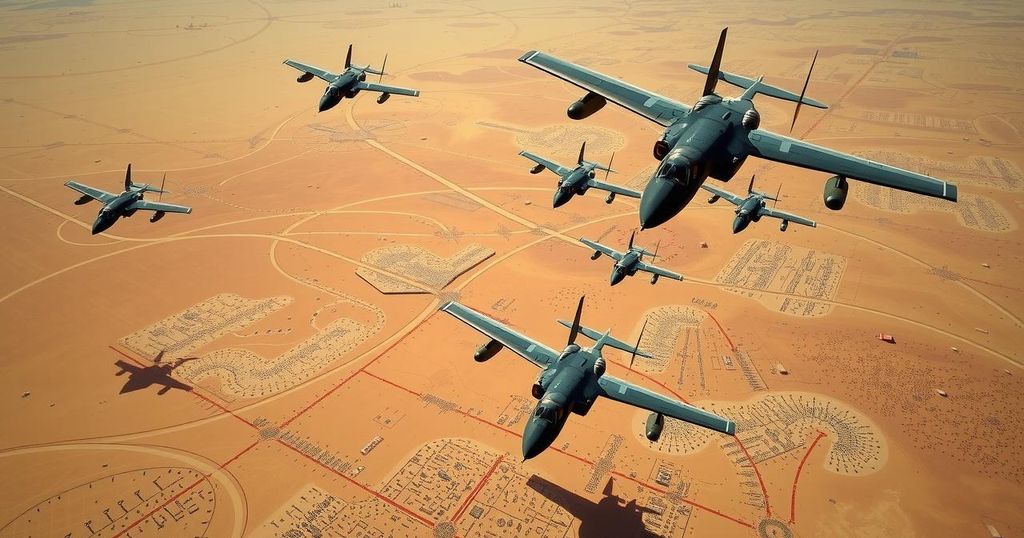Intensified Airstrike Campaign Against Yemen’s Houthi Rebels Under Trump Administration
The Trump administration has launched a new airstrike campaign against Yemen’s Houthi rebels, marked by increased intensity and frequency. Since March 15, 56 strikes have been reported, representing the highest engagement rate since U.S. operations began. Key Houthi leaders have been targeted, yet civilian casualty concerns remain unresolved. Experts express doubt about the efficacy of airstrikes in undermining Houthi resilience amidst ongoing peace negotiations.
The Trump administration has initiated a new and intensified airstrike campaign against Yemen’s Houthi rebels, reflecting a more robust military approach compared to prior policies. As per an Associated Press review, the campaign, which commenced on March 15, remains active, showcasing a marked increase in airstrike frequency within a condensed timespan.
The Armed Conflict Location & Event Data Project reported 56 American airstrike events between March 15 and March 21, indicating a significant uptick in military engagements compared to previous campaigns. Strikingly, this week marked the highest frequency of strikes since the inception of U.S. military operations in Yemen, particularly heightened since the onset of the Israel-Hamas conflict.
Expectations of further escalated strikes are heightened by the Trump administration’s new directives allowing U.S.-based forces in the Middle East to conduct offensive operations independently, contrasting the decision-making protocols under President Biden, which necessitated White House authorization for each attack.
Reported fatalities from the airstrikes amount to 57, according to Houthi sources, which is notably lower than the 106 deaths claimed by Houthi leader Abdul Malik al-Houthi for all strikes during 2024. U.S. National Security Adviser Mike Waltz indicated that several prominent Houthi leaders, including their primary missile operative, have been targeted, yet the Houthis have not confirmed any leadership losses.
This military escalation follows Houthi threats to target Israeli vessels due to restrictions on aid into Gaza. The Houthis had previously launched assaults on over 100 merchant vessels since the Gaza war’s commencement, which impacted maritime security in essential shipping lanes.
Under the Biden administration, U.S. military Central Command was transparent about airstrike details including targets and justifications. However, Central Command has since refrained from releasing similar information regarding the new campaign.
The U.K.-based group Airwars has suggested that at least five airstrikes may have resulted in civilian casualties, inferred from footage, Houthi claims, and additional evidence. The U.S. military’s official stance has denied any acknowledgment of civilian losses, labeling Houthi reports as disinformation.
The aircraft carrier USS Carl Vinson is deploying to the Middle East to supplement the USS Harry S. Truman stationed in the Red Sea, enhancing operational capabilities for U.S. forces in the region. Satellite imagery revealed the presence of B-2 stealth bombers at Diego Garcia, potentially available for use in Yemen operations.
Experts caution that airstrikes alone may be insufficient to dismantle the resilient Houthi control over significant territories in Yemen, particularly the capital, Sanaa. The current political fragmentation among Yemen’s exiled government complicates potential counteractions against the Houthis, with Saudi Arabia and the UAE seemingly shifting focus towards peace negotiations instead of renewed military engagement.
The recent airstrike campaign by the Trump administration represents a significant escalation in U.S. military action against Yemen’s Houthi rebels. This new approach has led to higher airstrike frequencies and a more independent operational environment for military forces in the region. However, the effectiveness of airstrikes alone remains questionable, especially with the Houthis maintaining strong territorial control amid ongoing peace discussions involving regional powers.
Original Source: abcnews.go.com








Post Comment